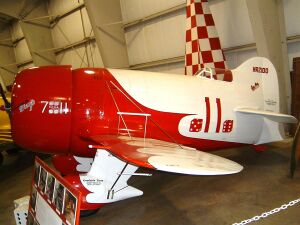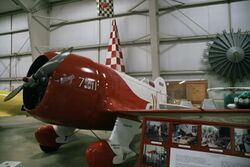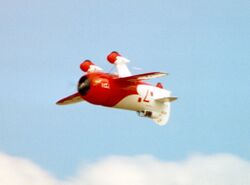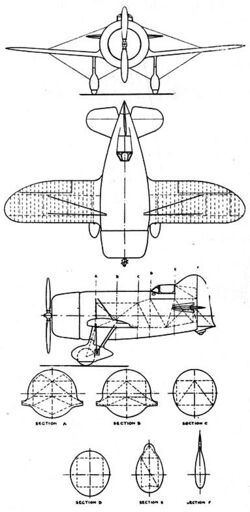Engineering:Gee Bee Model R
| Gee Bee Model R | |
|---|---|

| |
| Reproduction of the Gee Bee R-1 at the New England Air Museum. | |
| Role | Air racing |
| National origin | United States |
| Manufacturer | Granville Brothers Aircraft |
| Designer | Howell W. "Pete" Miller, Zantford Granville |
| First flight | 13 August 1932 |
| Introduction | 1932 |
| Produced | 1932-1933 |
| Developed from | Gee Bee Model Z |
The Gee Bee Model R Super Sportster was a special purpose racing aircraft made by Granville Brothers Aircraft of Springfield, Massachusetts at the now-abandoned Springfield Airport (Massachusetts).[1] Gee Bee stands for Granville Brothers.
Design and development
The 1932 R-1 and its sister plane, the R-2, were the successors of the previous year's Thompson Trophy-winning Model Z.
Assistant Chief Engineer[2] Howell "Pete" Miller and Zantford "Granny" Granville spent three days of wind tunnel testing at NYU with aeronautical engineering professor Alexander Klemin. The aircraft had a very peculiar design. Granville reasoned that a teardrop-shaped fuselage — especially as seen from directly above — would have lower drag than a straight-tapered one, so the fuselage was wider than the engine at its widest point (at the wing attachment point[s], within the length of the wing chord). The cockpit was located very far aft, just in front of the vertical stabilizer, in order to give the racing pilot better vision while making crowded pylon turns.
Operational history
The R-1 won the 1932 Thompson Trophy race, piloted by Jimmy Doolittle. He also set a new world landplane speed record of 476 km/h (296 mph) in the Shell Speed Dash. The distinction of a landplane record was noteworthy because, at that time, specialized speed seaplanes outran landplanes, e.g. the Macchi M.C.72 with over 700 km/h. The Springfield Union of September 6, 1932 quoted Doolittle as saying, "She is the sweetest ship I've ever flown. She is perfect in every respect and the motor is just as good as it was a week ago. It never missed a beat and has lots of stuff in it yet. I think this proves that the Granville brothers up in Springfield build the very best speed ships in America today."
The R-1 rapidly earned a reputation as a potentially very dangerous machine. This shortcoming was common to most air racers of the day. During the 1933 Bendix Trophy race, racing pilot Russell Boardman was killed, flying Number 11. During takeoff from a refueling stop in Indianapolis, Indiana , Boardman pulled up too soon, stalled the R-1 and crashed.[3]
The R-1 was later repaired and now incorporated a fuselage extension of approximately 18 inches, creating the "Long Tail Racer." This aircraft carried race number 11 and was named Intestinal Fortitude. It was decided not to rebuild the wings, but to use the original wings from the R-2, which had been removed in February 1933 when a new wing with flaps was built and installed. This aircraft crashed in a landing overrun incident soon after it was built, but Roy Minor, the pilot, was not severely injured. After another rebuild, the Long Tail Racer was sold to Cecil Allen. Against the advice of the Granvilles, Allen modified it by installing larger gas tanks aft of its normal center of gravity, which apparently made the aircraft unstable in pitch from tail-heaviness. Allen took off with a full fuel tank, crashed, and was killed. After this final crash, the aircraft was never rebuilt.[4]
Replicas
Non-flying replicas of the R-1 have been built at the New England Air Museum and the San Diego Air & Space Museum using original plans for the aircraft.[5] Another is displayed at the Lyman and Merrie Wood Museum of Springfield History at the Springfield Museums.[6] A flying replica of the R-2 was built by Steve Wolf and Delmar Benjamin that first flew in 1991.[7] Benjamin flew an aerobatic routine in this aircraft at numerous airshows until he retired the aircraft in 2002.[8] This aircraft was sold to Fantasy of Flight in 2004 and is on display in OrLampa, Florida.[9]
Specifications (Gee Bee Super Sportster R-1)
Data from "The Influence of Racing Types on Commercial Aircraft Design"[10]
General characteristics
- Crew: 1
- Length: 17 ft 8 in (5.38 m)
- Wingspan: 25 ft (7.62 m)
- Height: 8 ft 2 in (2.48 m)
- Wing area: 75 ft² (6.97 m²)
- Empty weight: 1840 lbs (834 kg)
- Loaded weight: 2,415 lbs (1,095 kg)
- Max. takeoff weight: 3075 lbs (1394.8 kg)
- Aspect ratio: 6.1
- Incidence: 2.5 Degrees
- Powerplant: 1 × Pratt & Whitney R-1340 Wasp 1,344 cubic inch (22 l) displacement Air Cooled 9 cylinder radial, 800 hp (596.5 kW)
Performance
- Maximum speed: 294.38 mph (473.8 km/h)
- Cruise speed: 260 mph (418.4 km/h)
- Stall speed: 90 mph (144 km/h)
- Range: 925 miles (1488 km) 630 miles, full throttle
- full throttle: 2.14 hours
- cruising: 3.65 hours
Note that the R-2 originally used a 550 hp Pratt & Whitney R-985 Wasp Junior nine cylinder radial powerplant, as the aircraft was designed primarily as a cross-country racer with increased tankage that did not require the larger 800 hp Wasp. In 1933, the R-2 was modified for closed-circuit racing and was fitted with the more powerful engine and cowling of the R-1 version. Other modifications included a larger wing, equipped with flaps.[11]
References
Notes
- ↑ http://www.airfields-freeman.com/MA/Airfields_MA_W.htm#springfield
- ↑ Haffke 1989, p. 99.
- ↑ Gilbert 1978, p.t 67.
- ↑ Graves, Darrell and Scott Brenner. "The Gee Bee 'R-1' and 'R-2'." dgraves549@aol.com, via web.archive.org. Retrieved: December 22, 2010.
- ↑ Wolf, Steve. "Gee Bee Super Sportster". EAA Sport Aviation, March 1992.
- ↑ Springfield Museums
- ↑ Benjamin, Delmar. "Flying The Gee Bee R-2". EAA Sport Aviation, March 1992.
- ↑ Bernier, Robert. "Bring Back the Brute." Air & Space Magazine, March 1, 2009.
- ↑ Beckett, Jamie. "Gee Bee And Delmar Plan New Lives Apart." avweb.com, January 21, 2004. Retrieved: September 18, 2011.
- ↑ Granville, Z.D. "The Influence of Racing Types on Commercial Aircraft Design." Aero Digest magazine, July 1933.
- ↑ Bowers 1965, pp. 33, 35.
Bibliography
- Benjamin, Delmar and Steve Wolf. Gee Bee. Osceola, Wisconsin: MBI Publishing Co., 1993. ISBN:0-87938-820-X.
- Bowers, Pete M. The Gee Bee Racers, Number 51. Leatherhead, Surrey, UK: Profile Publications Ltd., 1965.
- Granville, J.I. Farmers Take Flight. Springfield, Massachusetts: Copy Cat Print Shop, 2000. ISBN:0-9702493-1-4.
- Gilbert, James. The World's Worst Aircraft. Philadelphia, PA: Coronet Books, 1978. ISBN:0-340-21824-X.
- Haffke, Henry A. Gee Bee: The Real Story of the Granville Brothers and Their Marvelous Airplanes. Colorado Springs, Colorado: VIP Publishers, Inc., 1989. ISBN:0-934575-04-5.
- Mendenhall, Charles A. and Tom Murphy. The Gee Bee Racers: A Legacy of Speed. North Branch, Minnesota: Specialty Press, 1994. ISBN:0-933424-05-1.
- Schmid, S.H. and Truman C. Weaver. The Golden Age of Air Racing: Pre-1940, 2nd rev. edition (EAA Historical Series). Osceola, Wisconsin: MBI Publishing Co., 1991. ISBN:0-940000-00-8.
- Those Incredible Gee Bees (VHS 60 min). Springfield, Massachusetts: Studio 16, 1992.
- Winchester, Jim. The World's Worst Aircraft: From Pioneering Failures to Multimillion Dollar Disasters. London: Amber Books Ltd., 2005. ISBN:1-904687-34-2.
External links
- Website dedicated to the Gee Bee "family" of aircraft designs
- Free Fiddlers Green Paper Model site with a good Gee Bee history page; (Model opens in pdf file)
- "Doolittle Tames the Gee Bee" Story of the 1932 Thompson Trophy race. Includes quotes, photos, video




